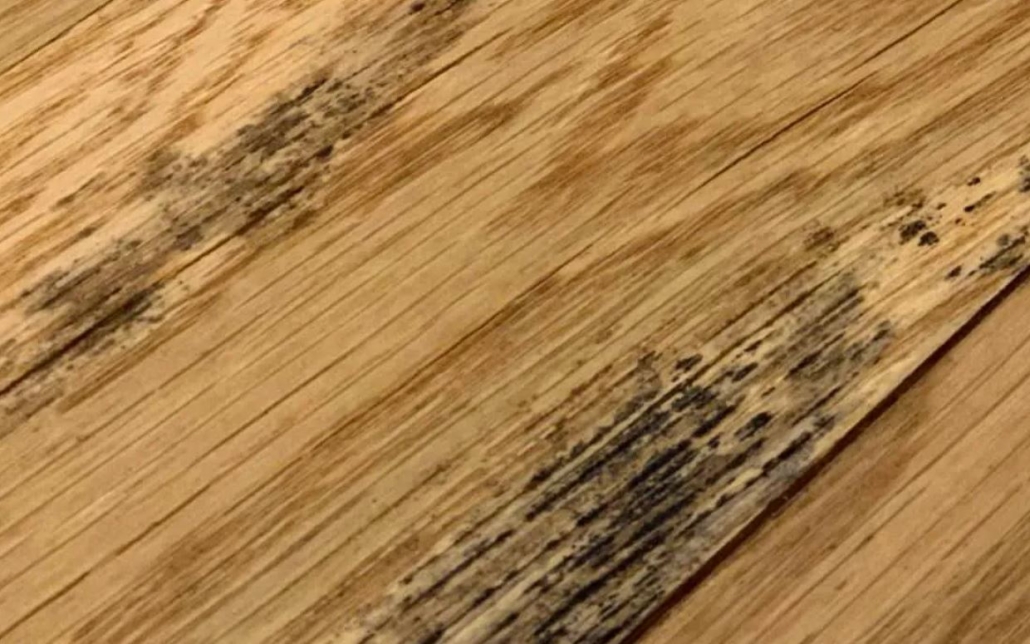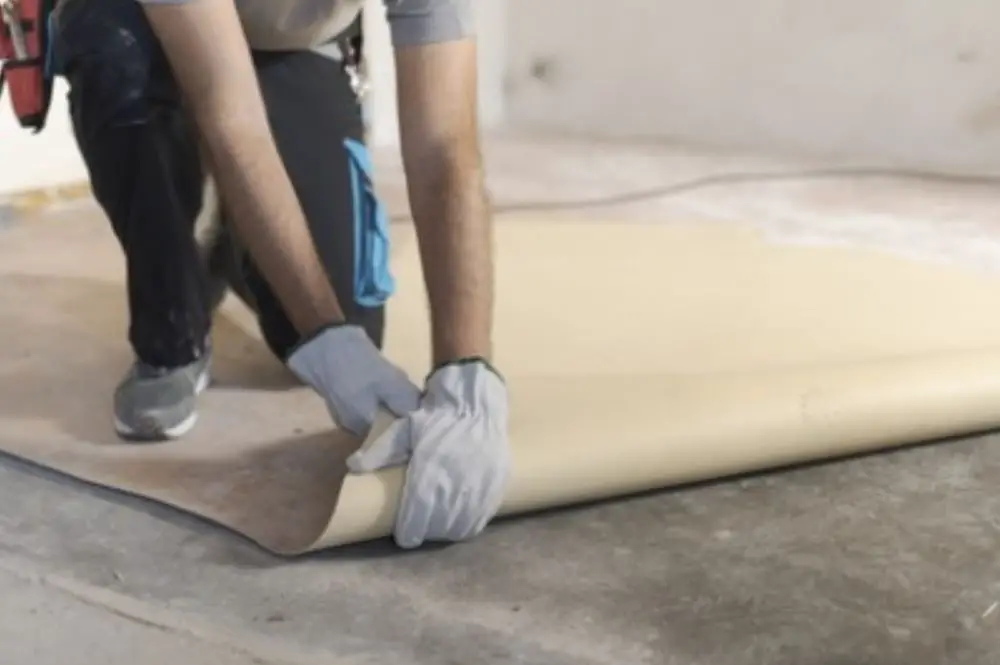Signs of Mold Under Hardwood Floors & How to Fix It

It’s common for homeowners to experience issues with mold on wood, especially in the spaces beneath their hardwood floors.
The basement, the bathroom, and the kitchen are particularly vulnerable because of their high humidity. There are many indicators of mold growth beneath hardwood flooring. They include a musty smell, texture, and color.
If you observe such symptoms, you should usually seek professional help. This article will cover the most noticeable indicators of mold under hardwood floors and advise how to eradicate them.
How Does Moisture Get Under Hardwood Floors
Hardwood flooring is a good choice for every room in the house due to its longevity and practicality. Apart from homes, this flooring is often used in business facilities to make the interior look more elegant and attractive.
However, most business and residential owners often overlook water damage to hardwood floors. Extreme wetness causes floor coverings to swell and cup, while low humidity causes them to dry out and crack. Now the question is, how much wetness can hardwood floors handle?
Your home’s interior might impact the floor’s functionality. Humidity tends to peak in the summer when the weather is warm. In contrast, humidity decreases during the cold winter when the heating is on, causing the flooring to shrink. You should, therefore, keep humidity levels between 35% and 55% year-round.
You can alleviate high humidity with air conditioning and a dehumidifier. When dealing with low humidity, a humidifier or steam humidification device can be helpful.
It is highly recommended that people who have hardwood floors buy a moisture meter. The Klein Tools Pinless Moisture Meter, is a fantastic option for a moisture meter that won’t damage your hardwood. This moisture meter has positive reviews from many users who have tried it.
What Causes Mold Under Hardwood Flooring

Mold grows on organic material subjected to high humidity levels or condensation. It means mold can grow under hardwood flooring if there is water damage or a flood.
It’s also possible to have too much moisture in your home’s environment without even noticing it. There may be mold spores everywhere, and no one can tell how they got there. You could also be living in a home with a hidden leak.
Mold can grow on wooden basement floors, so you must carefully check them for moisture levels. You should regularly drain a humidifier to avoid water damage if you have hardwood floors.
How Common Is It?
It’s common to see mold in a house or office. Mold thrives in damp environments like those left behind after a flood or where there have been roof, window, or pipe leaks.
It thrives on organic materials such as cellulose-rich paper, cardboard, gypsum board, and wood. Mold can grow on dust, paint, wallpaper, insulation, drywall, carpets, fabrics, and upholstery.
Cladosporium, Penicillium, and Aspergillus are the most prevalent types of mold you will find indoors. Nonetheless, researchers are still investigating how often certain molds infest buildings and residences.
Is Mold On Hardwood Floors Dangerous?
Some molds can indeed be dangerous, but not all of them. Black mold can cause many symptoms, from mild neurological problems to heart and lung problems that could be fatal.
If you don’t use a respirator or get rid of the mold immediately, it can get into your lungs, even if you’re meticulous about cleaning up after yourself. It’s important to regularly check for leaks in your plumbing and keep your bathrooms, kitchens, and other damp areas clean.
Avoid exposing your family to potential health risks by walking on moldy hardwood floors or looking at them. It will agitate the mold, releasing it into the surrounding air.
Before you have a filter mask, avoiding the moldy region is best. You should wear disposable gloves and properly dispose of them after mold removal.
How To Check For Mold On Hardwood Floors

Discoloration, staining, and the appearance of a fuzzy growth on the surface of a wooden floor are classic signs of mold. In its natural state, mildew can be black, white, green, gray, brown, or yellow. Also, their typical habitats include damp places with water or spillage.
Mold growth under a hardwood floor can be challenging to spot. However, the odor is noticeable. A strong, musty, earthy odor in your home could signify mold growth under the hardwood floor.
A musty stench under the sink, carpet, kitchen cabinets, and the basement is a clear sign of mold. If you don’t address the moisture issue, mold can harm your home’s hardwood flooring and your family’s health.
What Does Mold On Hardwood Floors Look Like?
Wooden floors can be infested by various molds, each of which has its unique appearance and potential causes. So, you don’t have to scratch your head to figure out what a hardwood floor mold looks like, here are the different types:
- Blue Stain. Blue stain is the name given to this mold’s darkened form. That is because the typical color of the stain is blue. On the other hand, it can also look black or gray sometimes.
- Decay Fungi. This mold is especially bad because its spores can go deep into the wood instead of staying on the surface. In most cases, a faulty pipe is to blame.
- Stain Fungi. This type of mold thrives on soaked wooden flooring. It has a longer window of opportunity for penetration on the hardwood than the others, but it won’t go as deep.
A mold’s origin might be as telling as its outward appearance. If water has damaged your hardwood floors for a long time, mold could also grow on them. That becomes clear if walking on the floor gives the impression of sinking.
Water stains might also be an indicator of mold growth. Mold may grow almost anywhere there is water or a lot of humidity, so it’s important to keep those things at bay.
What Are The Signs Of Mold Under Your Hardwood Flooring?
These are the most common signs of mold under your hardwood flooring.
Stale, Musty Smell
When a surface is wet, mold can quickly spread. A musty odor in your home signifies mold is beginning to grow due to water damage. You can deal with a musty odor beneath hardwood floors in a few different ways. First, you can get rid of the dust and spores responsible for the musty odor by installing an air purifier.
Adding a dehumidifier can help lower the humidity in your home, making it less likely that mold will grow there. When dealing with mold under floors, this procedure can be useful. You can either spray the mold with a solution of bleach and water or scrape it off with a brush.
Still, if you can’t put your finger on what’s causing the musty odor, a mixture of these approaches should do the trick.
Spongy Flooring
Because of its stealthy nature, mold can be difficult to spot. If mold grows on wooden floors, you should call a company that treats mold. For example, if there is too much moisture inside and it stays there, mold may start to grow on the floorboards.
The mold’s musty odor and black appearance may upset you if you have hardwood floors. Molds grow in a radial pattern and smell like rotting plants, thus, musty. Black mold, the most dangerous type, can appear in many colors.
If you see red or black mold developing on the floors, there is a moisture issue somewhere in the house. If you could get rid of it immediately, that would be ideal. Mold spreads rapidly in humid environments, and the direr the situation, the faster it will spread.
Neurospora is likely the cause of any musty odors in your home, whether from the flooring or the food. Determine where the mold came from and what kind it is to deal with it properly.
Water Damage
If you have water damage on your floor, especially if the floor is slippery, you have a mold infestation. Finding watermarks on your wood means that water has been resting on it for a long time.
Various techniques exist for removing mold from under wooden floorboards. A quantitative assessment of the moisture level is necessary before removing mold. A hardwood floor moisture meter is one tool that can help you achieve this goal. After that, you’ll know if you need to replace your floor.
How To Know If There Is Mold On The Sub Floors

Subfloors are the unfinished flooring layers beneath the finished flooring. Finish flooring options include hardwood, laminate, vinyl, or ceramic tile. It is usually the first layer of flooring that goes on top of the joists.
Most of the time, mold grows on the Subfloor because moisture gets between the flooring layers without anyone noticing. That is especially true when the final flooring is sheet vinyl, laminate, or ceramic tile. The wetness will be noticeable and easy to find if you have carpeted floors.
However, it can be challenging to locate mold growth on the subfloor. You can’t see it since it’s hidden beneath your finished flooring. You might be able to detect the odor, though. A common characteristic of most molds is a musty, earthy, and often offensive scent. Spending even a short time in a space where mold is present might trigger allergic reactions in those susceptible to it.
Do Subfloors With Mold Need To Be Replaced?
Subflooring replacement is usually unnecessary unless there is water damage. But if there is a lot of water damage from flooding or long-term exposure to moisture, it may be necessary to remove the damaged parts.
That will keep the structure strong and prevent mold from growing. The subfloor often needs to be replaced when a home has water damage or a mold problem.
Steps For Dealing With Mold On Your Hardwood Floors
- Clear the room.
- Seal the doors to the rest of the house.
- Open windows and point a fan towards them.
- Remove floorboards in affected areas.
- Treat the subfloor with an anti-mold formula.
- Salvage and clean the remaining good wood.
- Clean and disinfect the remaining wood and Subfloor to prevent recontamination.
- Replace the hardwood flooring.
FAQs

Q: What Kills Mold Under Flooring?
Although there is no specific way to deal with it, a holistic approach is ideal. If mold is growing under your flooring, you should fix the cause, eradicate the mold, and then replace the flooring.
Q: How Does One Check for Mold Under a Floor?
Usually, the most obvious sign of mold is the appearance of black spots. Mold, however, loves to grow in your home’s damp, dark, and warm crevices, like under the floorboards. If you notice any musty odors or discolored floorboards, mold is likely growing beneath your floors.
Q: Can Mold on the Subfloor Make You Sick?
Everyone in the house, especially babies and the elderly, is at risk of getting sick from mold-related infections. Lung infections are possible for anyone who comes into contact with mold. Allergy infections are often the root cause of this illness’s initial symptoms, whether they last a few days or decades.
These infections can cause short-term symptoms like trouble breathing, headaches, and nasal congestion. However, mold can also cause skin irritation, red eyes, and a scratchy throat.
Q: What Does Mold Under Wood Floor Look Like?
Stains, discoloration, and fuzzy growth on a wooden floor surface are classic signs of mold. Mold can appear in colors such as white, black, green, gray, yellow, and brown.
Q: What Are Signs of Mold Exposure?
Mold in the home doesn’t always make people sick, but it can cause other problems. They include asthma-like symptoms, such as those listed below.
- Coughing
- Sore throat
- Eye irritation
- Sneezing
- Headache
Most people who are exposed to mold don’t need immediate medical attention.
Q: Can I Leave Vinegar on Mold Overnight?
Because it kills bacteria and fungi, vinegar can be a cheap and effective treatment. However, mold removal should wait until the source of the moisture has been fixed. If you try to eradicate the mold without fixing the water problem, the mold will come again.
Q: Does Moldy Subfloor Need to Be Replaced?
As a result of mold growth, you should replace the subfloor. Moldy wood, when chopped, releases spores into the air and requires extra caution. Sealing moldy wood from the subfloor in a double bag is important before dumping.
Q: What Does Subfloor Mold Look Like?
Most of the time, mold grows in the subfloor because of water leaks under the floor or there’s an unfound leaky pipe. Pay attention to discoloration and a musky odor to notice the mold.
Q: Is There a Spray That Kills Mold?
Yes, there are mold control sprays. Using them with other holistic methods can eliminate mold.
Q: Can mold grow under hardwood floors?
Mold is common in the house, but its effects on hardwood floors can be disastrous. Because of a lack of ventilation following water damage or flooding, the subfloor frequently becomes damp and moldy. Mold can start developing in less than 48 hours.
Difference Between Mold and Mildew
The Environmental Protection Agency (EPA) states that mildew and mold are not much of a distinction. Both are fungi that grow well in damp places and are often found in homes with water damage.
Difference Between Mold and Mildew
Mold can come in various colors and textures, including dark green and black, and is often slimy or fuzzy in appearance. Mildew has a powdery consistency and grows in a flat, white or grayish color on any surface it finds.
You can easily remove mildew with just about any household cleanser, a scrub brush, and a bit of time and effort. Mold doesn’t usually grow in well-kept homes, but if it does, it can be hard to eradicate and may mean you have to replace things like drywall or ceiling tiles.
What are the side effects of black mold?
The respiratory system can be affected by exposure to black mold. Black mold exposure or poisoning can cause a wide range of symptoms, such as:
- Persistent coughing and sneezing.
- Irritation of the eyes and mucous membranes of the nose and throat.
- Rashes.
- Chronic lethargy.
- Persistent headaches.
Conclusion

Mold can develop on hardwood floors for a variety of reasons. The dampness in your house could be to blame, or you don’t give your floors a good scrub regularly.
The information in this article will be handy to protect your family from mold and save time and money. You can fix this problem with both professional chemical solutions and home remedies.


